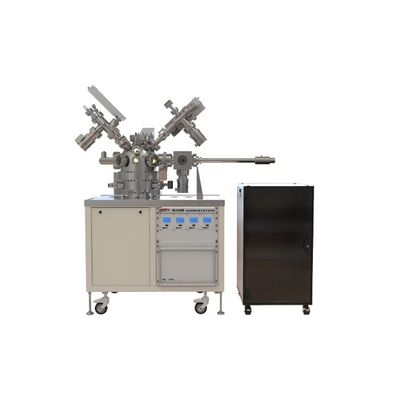

- Home
- Companies
- Hiden Analytical Ltd.
- Products
- Hiden - Model SIMS/SNMS Workstation - ...

Hiden - Model SIMS/SNMS Workstation - UHV Surface Analysis System for Thin Film Depth Profiling
Hiden Analytical provides extremely versatile high-sensitivity instrumentation for high performance dynamic and static SIMS (secondary ion mass spectrometry) analysis, unlocking new levels of precision in cutting-edge applications. With an extended range and the ability to acquire and identify both positive (+ve) and negative (-ve) secondary ions, the SIMS workstation is a comprehensive solution for composition analysis and depth profiling applications. For simultaneous +ve and -ve ion analysis in a comprehensive SIMS package, Hiden Analytical has also developed the innovative Hi5 SIMS workstation.
Secondary ion mass spectrometry, or SIMS, is one of the most sensitive techniques ever developed for interrogating the uppermost surface layers of a material, from depths of several hundred nanometres (nm) to a single atomic layer. It can obtain compositional data down to the parts per billion (ppb) range and is compatible with any material that can reliably be tested in vacuum conditions. Consequently, SIMS instruments are routinely used to analyse ceramics, metals, organic materials, polymers, semiconductors, and more.
This technique is broken down into two distinct methodologies: dynamic and static SIMS. Each of these uses a primary ion beam that impacts a sample in vacuum conditions, causing extremely small volumes of material to be ablated from the surface – a fraction of this ejected material will be ionised. These secondary ions are acquired by the sample inlet of the mass spectrometry unit to develop a robust understanding of the composition of the specimen’s uppermost surface layers.
The primary difference between dynamic and static SIMS is the ion dosage (a higher dose for dynamic SIMS instruments), and that dynamic SIMS cannot be run with a defocussed ion beam; it must be raster scanned across the sample surface to produce a flat-bottomed crater. Hiden Analytical’s SIMS workstation can perform both dynamic and static SIMS analysis in a single consolidated SIMS instrument. With a dual-mode MAXIM mass spectrometer, the SIMS workstation can operate in secondary ion detection mode for +ve/-ve ion detection, and in a secondary neutral detection mode for +ve data quantification. Each mode is compatible with mass range options up to 5000 atomic mass units (amu).
Hiden Analytical’s SIMS Workstation
Our SIMS workstation is a comprehensive solution for depth profiling and compositional analysis of samples in various areas of surface analysis, thin film engineering, nanotechnology, fuel cell research, and more. The system is highly customizable to suit the unique requirements of users in complex fields.
If you need more information about performing static or dynamic SIMS analysis, browse our product literature and presentations. For a more detailed insight into the features of our SIMS workstation, simply contact a member of the Hiden Analytical team today.
- Hiden MAXIM SIMS analyser operating under MASsoft 7 Professional for ppb analysis
- Integrated ioniser for efficient SNMS analysis
- Choice of differentially pumped primary excitation sources
- IG20 Gas, IG5C Caesium, IFG200 FAB or high performance liquid gallium guns
- Integral ion gun raster control with signal gating for depth profiling
- Electron flood gun option for charge neutralisation in insulator studies
- Vacuum chamber bakeout heaters
- Fast sample transfer, sample holder and manipulator with load lock
- UHV manipulator for optimum sample positioning
- SIMS elemental imaging option with ESM LabVIEW SIMS Imaging program
- Static SIMS Spectral Library available
- Automatic SIMS ion optics lens tuning
- Automatic mass alignment for optimum SIMS performance
A comprehensive solution for depth profiling and surface composition analysis
The SIMS Workstation combines dynamic and static SIMS analysis with a dual-mode mass spectrometer for positive (+ve) and negative (-ve) ion detection, and an additional secondary neutral mass spectrometry (SNMS) detection mode, for superior flexibility in surface analysis applications. Find full specifications below:
- Mass range: 300, 510 or 1000 amu
- Minimum detectable concentration: PPM/PPB level contamination analysis
- SIMS – Secondary Ion Mass Spectrometry: Yes
- Analysis of ions ejected from sample surface: Yes (primary ions of oxygen, argon or caesium)
- SNMS – Secondary Neutral Mass Spectrometry: Yes
- Analysis of ions ejected from sample surface: Yes (primary ions of oxygen, argon or caesium)
- Depth resolution: +/- 5 nanometer
- Minimum detectable concentration – SIMS: 1016 atoms per cubic centimeter – species dependent
- Minimum detectable concentration – SNMS: 0.01% – species dependant
- UHV multiport chamber: Yes
- Accommodates additional instrumentation: Yes (E.g. XPS)
